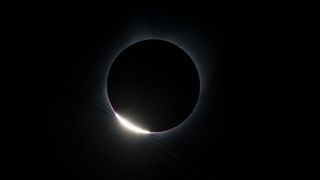When is the next solar eclipse?
The next total solar eclipse visible from North America is coming April 8, 2024. Here’s everything you need to know about how to watch the next solar eclipse.

One of the most significant celestial events is coming to North America this spring — a total solar eclipse.
Total solar eclipses are uncommon and dynamic events, resulting in one of nature's most spectacular sights. Here's everything you need to know about the next eclipse.
When is the next total solar eclipse?
The next total solar eclipse will occur on Monday, April 8, 2024, when it will be possible to experience darkness in the daytime and briefly see the sun's corona — or outermost atmosphere — with the naked eye. The total eclipse will be visible from parts of Mexico, the U.S. and Canada. Exactly what time of day it happens depends on where the observer will be watching from in North America.
What is the eclipse's path of totality?

"Totality" is the name for the moment when the sun appears completely obscured by the moon. The path of totality is the narrow zone from which totality is visible on Earth. Technically, this path is just the movement of the moon's shadow across the world — specifically, the places where the moon's umbra, the darkest central part of its shadow, is projected across the Earth's surface. To experience totality, you must be within this zone.
On April 8, 2024, the path of totality will be around 10,000 miles (16,000 kilometers) long and approximately 115 miles (185 km) wide. It will begin in northwest Mexico, crossing parts of the states of Sinaloa, Durango and Coahuila. It will then cross parts of 15 contiguous U.S. states: Texas, Oklahoma, Arkansas, Missouri, Illinois, Kentucky, Tennessee, Michigan, Indiana, Ohio, Pennsylvania, New York, Vermont, New Hampshire and Maine. Parts of Canada's provinces, Ontario, Quebec, New Brunswick, Prince Edward Island and Newfoundland, will also experience totality.
When was the last total solar eclipse?
The last total solar eclipse in North America was on Aug. 21, 2017, when the path of totality crossed 14 U.S. states from Oregon to South Carolina. Alaska will experience a total solar eclipse on March 30, 2033, with the contiguous U.S. experiencing its next total solar eclipse on Aug. 23, 2044.
Related: The best photos of the Oct. 14 'ring of fire' eclipse over North America

What is a total solar eclipse?
A total solar eclipse is the result of a remarkable coincidence. The moon's apparent size in our sky is about the same as the apparent size of the sun; the sun is 400 times larger than the moon, but also about 400 times farther away. A New Moon — the lunar phase that occurs when the moon moves between Earth and the sun — can block the sun during two short “eclipse seasons” each year. If the moon blocks only some of the sun, we see a partial solar eclipse. If the moon eclipses the sun while slightly farther from Earth, it's an annular solar eclipse (often called a “ring of fire”). Only when the moon perfectly blocks the sun can a total solar eclipse result.
How often do total solar eclipses occur?
Every year, there are at least two solar eclipses of some kind, but there can be as many as five. Mostly, they're partial solar eclipses, but total solar eclipses are not rare. On average, a total solar eclipse occurs about once every 18 months somewhere on Earth. However, you'd have to wait an average of 375 years to see two total eclipses from one place, according to eclipse expert and ex-NASA eclipse calculator Fred Espenak.
How long does a total solar eclipse last?
The full duration of a total solar eclipse — starting from when the moon begins to eclipse the sun, before reaching totality and finally moving away again — takes about three hours. However, totality itself is very short. It lasts from a single second to a maximum of 7.5 minutes, according to timeanddate.com. On April 8, 2024, totality will last for up to 4 minutes and 28 seconds,depending on where you are within the path of totality. Those closer to the center of the path of totality will experience a longer duration.

Can you look at a total eclipse?
You MUST use proper eye protection — such as high-quality eclipse glasses — to look at the eclipse's partial phases on either side of totality; failure to do so could result in serious eye damage.
However, it is perfectly safe to look at the eclipse with the naked eye during totality, if you are within the path. That is the very reason why a total solar eclipse is so special.
Sign up for the Live Science daily newsletter now
Get the world’s most fascinating discoveries delivered straight to your inbox.
Jamie Carter is a freelance journalist and regular Live Science contributor based in Cardiff, U.K. He is the author of A Stargazing Program For Beginners and lectures on astronomy and the natural world. Jamie regularly writes for Space.com, TechRadar.com, Forbes Science, BBC Wildlife magazine and Scientific American, and many others. He edits WhenIsTheNextEclipse.com.
Most Popular

By Harry Baker

By Sascha Pare